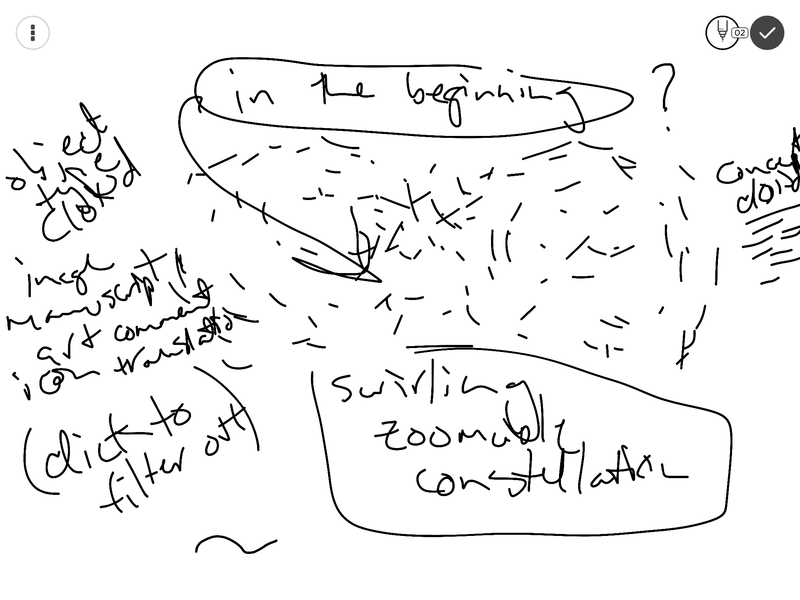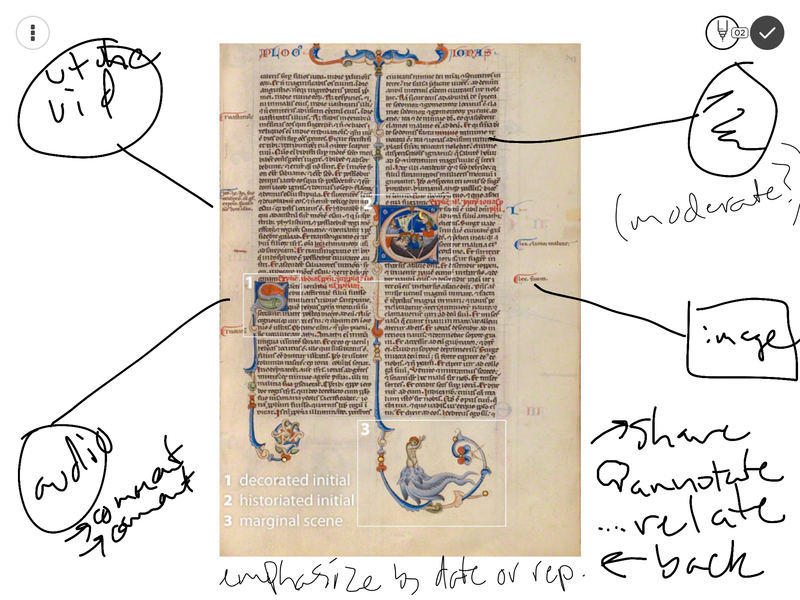proxinity - contact without grasp
Through the generous support of the Baker-Nord Center for the Humanities at Case Western Reserve University, I have had the privilege of working with an inspiring and inquisitive team to collaboratively explore ways in which digital media technologies might unsettle our notions of sacred text translation. Over the past year, Timothy Beal, Sarah Gridley, Eric Pellish, William Deal, and I have been working remotely and residentially to imagine a web application that would shape a disposition of attention to ambiguity in the translation processes of Genesis 1.1. This ongoing project through Baker-Nord deeply shapes one of the material bible experiments in a proximate bible, which I have called “facing the deep.” Below I outline some early discussions of interface possibilities for this web application, including my incredibly rough sketches.
Even though our current project app is called Tohu, I am toying with an app name of proxinity as a mashup of proximity and infinity to signal my value on shaping dispositions toward reading as contact without grasp. Sarah Gridley helpfully raised the concern that “contact without grasp” could connote a kind of consumptive tourism or voyerism. This is decidedly NOT what I am hoping from proxinity. So, along the way, I hope to reflect on the difference between cantact as consumptive tourism that tokenizes and contact as encounter that engages deeply without a demand for full comprehension.
hints and openings
Several technologies have shaped my imagination of what might be possible in an app that facilitates dispositions of close reading, encounter and opening.
- diigo a deeply collaborative tool where communities can annotate and discuss web artifacts in the space of the ‘page’ itself. A wonderful enactment of participatory reading as making. Diigo also has some social media aggregation possibilities than can lead to further conversation around fragments.
- rebelmouse My prefered social media aggregator and an integral part of this dissertation project. Rebelmouse is a hashtag structured community aggregation tool that can pull together endless channels into a stream. What I love about rebelmouse is the spatial proximity of fragments that come from all kinds of different sources, both people and platforms.
- genius - The Waste Land Genius is a fantastic tool for crowd/community annotation of text that allows media annotations as well as text. Another tool that embodies reading as making, but I wish the base text didn’t remain so dominant in the space of the tool. Genius is a new media translation of marginalia of sorts, but with a different spatiality determined by a digital notion of page.
- on broadway A recent project by one of my favorite new media scholars, Lev Manovich, and others. Both a physical installation and a web application that perform a material media translation of a 1966 print piece. A radically new spatial rendering of life in the city using large and dynamic social media data sets. The infinite entanglement of data and interface in this project is a great model for making new media objects.
- ArtLENS A new media translation of access to a fixed museum collection. ARTLens has many interesting features in both the large touchscreen installation and the mobile app, especially realted to user generated pathways as a part of the growing dataset.
two lobes of infinity
I think of our application design as the constant interplay of the two lobes of the infinity sign.
Lobe 1 - An ongoing and iterative machine learning process taking data from sources and from user interaction and creating correlative metadata via semantic connection to conceptual domains.
- OCR and image recognition tools ‘read’ media for potential terms or attributes that can be passed into the conceptual algorithm map for metadata processing.
- Using an object oriented database problematizes the strict database/interface dichotomy often operative in app design.
- Natural language processing provides the algorithms to take streams of data and find correlations between artifacts and create the corresponding metadata by moving back and forth between semantic and conceptual realms. My colleague Justin Barber suggests we look at a tool called WordNet to help our application correlate semantic data with higher order conceptual frameworks to enable metadata correlations beyond direct semantic or linguistic equivalence. Here, at the programmatic level, we would be embodying a value on problematizing simple notions of equivalence in translation.
Lobe 2 - Rendering an interface that allows user interaction with and participation in constellations of artifacts that make up the lives of a text/tradition.
- Interface will model contact without grasp and hopefully develop new reading dis-positions toward attention to ambiguity.
- We could moderate user input regarding additional artifacts and possible correlations between and feed into machine learning process.
- Like ARTLens, we could also use user pathway data as a source for NLP metadata learning.
begin with NRSV
The proxinity interface could offer one translation as the initial point of contact. I suggest NRSV here simply out of pragmatics of possible translation projects in the near future.
One alternative here would be to randomly select one translation/version from the existing dataset as the initial contact text, limited by browser language setting and/or user profile preference.
define units
Ideally, emulating the Genius platform, we would have an algorithm and an interface that would allow users to select a portion of text (e.g. highlight 3 words or entire sentence) and have the application generate the corresponding constellation on the fly based on selection. Yet, perhaps for an initial phase, we define units of text from the chosen contact translation (NRSV) and make these independently touchable to move into the corresponding constellation.
Artifacts in the collection could appear in many constellations depending on the NLP constructed metadata and its connection to multiple portions of the contact text.
Initial Interface
Users arrive at app and are presented with the contact translation as NRSV. A touch on a portion of text zooms to that portion of text as shimmering objects making up letters, almost as if letters are buzzing and then these objects release from formation in letters into a slowly swirling constellation of objects.
Should we keep the contact text phrase on the screen above the swirling constellation to remind user of their path?
 To the left of the constellation will be a clickable cloud of object type toggles to allow filtering of artifacts in constellation by particular object types. All types will be on by default. Clicking on a type marker one time will remove that object type from the constellation and clicking again will bring these objects back into the swirl. To the right of the constellation will be a clickable cloud of concept toggles for filtering in a similar fashion.
To the left of the constellation will be a clickable cloud of object type toggles to allow filtering of artifacts in constellation by particular object types. All types will be on by default. Clicking on a type marker one time will remove that object type from the constellation and clicking again will bring these objects back into the swirl. To the right of the constellation will be a clickable cloud of concept toggles for filtering in a similar fashion.
We could have countless clouds or cascading clouds that allowed filtering by different attributes (language, time period, genre, etc.)
 Our team discussed having ways to organize the swirling artifacts (e.g. versions) by time or other attribute for pedagogical aims (e.g. show historical trajectory of translations for comparison and showing geneology).
Our team discussed having ways to organize the swirling artifacts (e.g. versions) by time or other attribute for pedagogical aims (e.g. show historical trajectory of translations for comparison and showing geneology).
item view
A click on any object will bring it into focus and show annotations, share options, and maybe even a way to suggest correlation with another object in constellation (search by concept). The annotation feature will allow general comments and spatially located point specific annotations. All annotations can be text, image, html embeds, audio, or video.
I’m guessing we will want annotation moderation of some sort and definitely require account registration to participate like this. I would like to call this participation “translation,” to emphasize the point that participating in the engagement of a text and tradition is translation.
 Item view will also offer clickable clouds of related concepts and object types as in constellation view. Yet, in item view, a click on a cloud item will take user to a new constellation based on their selection to move to other constellations.
Item view will also offer clickable clouds of related concepts and object types as in constellation view. Yet, in item view, a click on a cloud item will take user to a new constellation based on their selection to move to other constellations.
Maybe the object type cloud would keep user in the same contact translation space but give constellation of similar object types as item. BUT, concept cloud would take user to new constellation not based on contact translation segment, but rather on conceptual attribute. In this case, we would need a way for users to move from conceptual constellation to related contact translation segments? Maybe one of the material limits we put on the interface is that access to constellations is always tied to contact translation segment?
In item view, a squeeze motion will go back to constellation.
sources
We would recruit our friends to help find suitable sources for artifacts that our algorithm could use for ongoing training and collecting. Many sources are already available and we will be building both an aggregation of these existing sources and asking for people to contribute artifacts (e.g. drawings or pictures of catacomb art related to a contact translation segment). All artifacts included would come with source link so that user can always push out to other spaces for further exploration. I have no desire to keep user traffic inside app or to absorb artifacts into our own dataset! We will simply use pointers to sources but we will handle annotations, etc. within the app. Some possible sources or source types might be:
- bible.com for translations
- versions in ancient languages as well (not THE Hebrew, but a set of Hebrew/Greek/etc. versions that shape contact with this passage, let’s not even assume MT as original :) )
- literature (ancient near east creation epics)
- art
- manuscripts (e.g. api for sinaiticus or for U of Michigan collection, etc.)
- video (initially cull textual metadata from vimeo and youtube description, title and even captions. beyond this, there are tools that can watch the video and extract metadata)
- music
- architecture
- social media engagement with related hashtags